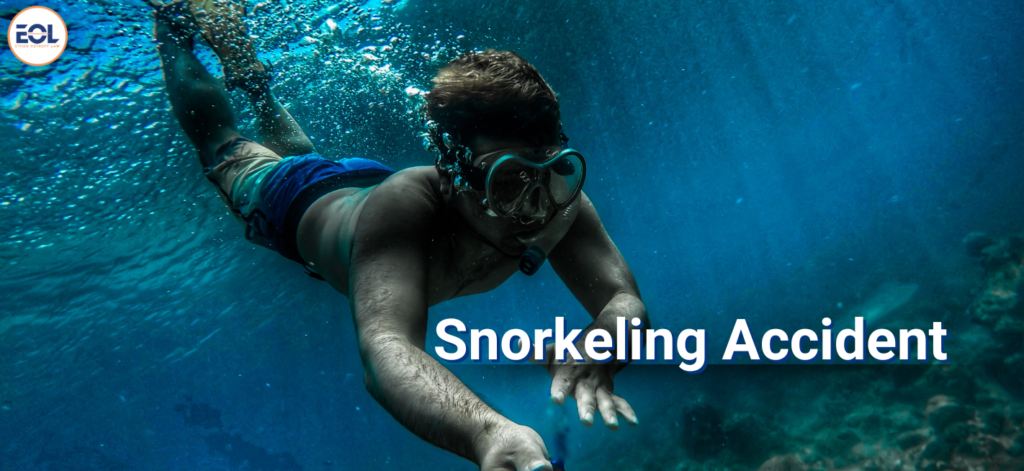Snorkeling Accident Lawyer | Ethen Ostroff Law
Picture yourself basking in the sun’s warmth, the gentle rhythm of waves caressing the shore, and the thrilling sensation of delving into the underwater realm. Snorkeling beckons with its blend of serenity and excitement, offering a firsthand encounter with the mesmerizing marine life. Yet, beneath this surface allure lies the potential for mishaps. Snorkeling accidents can strike unexpectedly, resulting in severe injuries and legal complexities. If you find yourself grappling with such a scenario, the prospect of a budding snorkeling accident lawsuit might feel daunting. But fret not. A snorkeling accident lawyer from Ethen Ostroff Law can guide you through every step of the process.
Snorkeling in American Culture
Snorkeling in the United States is deeply woven into coastal culture, drawing enthusiasts from across the nation and beyond. From Hawaii’s pristine waters to Florida’s vibrant reefs, the country boasts diverse snorkeling opportunities. Whether you favor tropical seas or freshwater environments, there is something beneath the waves for everyone. With the right equipment and a sense of adventure, snorkeling in the country offers unforgettable experiences for nature lovers and water enthusiasts alike.
Top Snorkeling Destinations in the United States
The United States is home to multiple snorkeling destinations that offer unforgettable experiences for snorkelers of all levels, from beginners to experienced enthusiasts, including:
- Anacapa Island, California: Known for its clear waters and diverse marine life, including dolphins and sea stars.
- Bahia Honda State Park, Florida: Ideal for beginners to get a taste of snorkeling, with opportunities to see immature fish and seagrass.
- Block Island, Rhode Island: Surf Beach offers shallow waters perfect for exploring, with equipment available for rent nearby.
- Cinnamon Bay, Virgin Islands: Known for its pristine beaches and vibrant coral structures, home to Caribbean fish like barracuda and butterfly fish.
- Dry Tortugas, Florida Keys: A wonderland of colorful reefs and marine life, including starfish and king crabs, accessible from the white sandy beach.
- Georgia Aquarium, Atlanta, Georgia: Offers the chance to snorkel alongside whale sharks and manta rays in a controlled environment.
- Kona, Hawaii: Volcanic bays teeming with marine life, with the opportunity for a magical manta ray night snorkel experience.
- La Jolla, California: La Jolla Cove is home to a variety of sea creatures, including sea turtles and leopard sharks, best visited between June and September.
- Navarre Beach, Florida: Marine sanctuary with offshore reefs making it easy to spot turtles, stingrays, and various fish species.
- Santa Catalina Island, California: Two Harbors boasts clear waters and abundant marine life, accessible via sandy beaches or kayak, with rentals and guided trips available.

Top Snorkeling Locations in Pennsylvania
Pennsylvania’s freshwater snorkeling spots offer unique experiences amid the state’s natural beauty:
- French Creek State Park: Hopewell Lake boasts clear waters, revealing submerged tree stumps and diverse fish species in this scenic southeastern Pennsylvania park.
- Laurel Hill State Park: Tranquil mountain lakes, like Laurel Hill Lake, in the Laurel Highlands, provide excellent visibility for observing aquatic plants and wildlife up close.
- Presque Isle State Park: Along Lake Erie’s shores, snorkelers can explore underwater rock formations and diverse fish species in shallow areas and beaches.
- Raccoon Creek State Park: In southwestern Pennsylvania, Raccoon Creek and its lake offer opportunities to explore underwater rock formations and spot aquatic wildlife.
- Yellow Creek State Park: The picturesque lake at Yellow Creek State Park in the Allegheny Plateau region is ideal for observing fish, turtles, and other aquatic inhabitants in calm waters with a sandy bottom.
These freshwater destinations offer a chance to discover Pennsylvania’s natural wonders beneath the surface.
Prevalence of Snorkeling Accidents in the US
Snorkeling accidents in the US reveal a mix of challenges and precautions:
- Each year, roughly 10 snorkeling-related deaths occur in the US among the 2 million enthusiasts who dive in. That’s about five fatalities per million snorkelers, with heart issues accounting for around 2 of those cases.
- Snorkeling accidents stem from various factors, including heart problems, drowning incidents at the surface, injuries, and existing health conditions. Older men with heart troubles face higher risks.
Is Snorkeling High-Risk?
Snorkeling is typically seen as a low-risk activity. But like any water-based endeavor, it comes with potential hazards. These risks increase if safety protocols are ignored or if snorkelers explore challenging or unknown areas.
Potential Risks and Hazards in Snorkeling
While snorkeling is generally a safe and enjoyable activity, it is important to recognize these potential risks and hazards to ensure a safe experience:
- Drowning: Improper use of snorkeling equipment or rough sea conditions can lead to water inhalation and drowning.
- Entrapment: Watch out for underwater obstacles like rocks and vegetation, which can entangle or trap them.
- Equipment malfunction: Regularly inspect and maintain snorkeling gear to prevent equipment failure underwater.
- Fatigue and overexertion: Snorkeling can be physically demanding, especially in strong currents or when exploring vast areas. Take breaks and pace oneself to avoid exhaustion.
- Hypothermia: In colder water, wear appropriate attire to prevent hypothermia and maintain body temperature.
- Marine life: While most marine life is harmless, some species can cause stings or bites if disturbed. Be cautious around venomous creatures.
- Sun exposure: Protecting against sunburn and dehydration is important in sunny, tropical locations where snorkeling often occurs.
- Underwater hazards: Sharp coral and rocks can cause injuries. Swim cautiously and avoid touching marine life.
- Water conditions: Be aware of currents, waves, and tides to prevent accidents and stay oriented underwater.
Causes of Snorkeling Accidents
Snorkeling accidents can happen unexpectedly, often due to various factors. Understanding these common causes is crucial for ensuring a safe underwater experience. Here are some primary reasons for snorkeling accidents:
- Diving incidents: Going too deep or attempting breath-holding dives without proper training can lead to shallow water blackout or decompression sickness.
- Environmental factors: Changes in weather, water conditions, or marine life behavior, like strong currents or sudden storms, can catch snorkelers off guard.
- Equipment issues: Malfunctioning gear, like leaky masks or broken fins, can compromise safety and cause distress underwater.
- Inexperienced snorkelers: Lack of experience in buoyancy control or navigation underwater can lead to panic and mishaps.
- Lack of supervision: Snorkeling without proper guidance, especially in remote areas, increases the risk of accidents.
- Negligence by operators or instructors: Failure to provide safety briefings or respond effectively to emergencies can result in serious incidents.
- Overexertion and fatigue: Physical exertion while snorkeling can impair judgment and increase the risk of exhaustion or cramps.
- Underlying medical conditions: Pre-existing health issues like heart problems can exacerbate risks associated with snorkeling.
- Underwater hazards: Colliding with sharp rocks or getting entangled in marine debris can cause injuries.
By addressing these factors with education, preparation, and adherence to safety guidelines, snorkelers can minimize risks and enjoy a safe underwater experience.
Common Injuries Resulting from Snorkeling Accidents
Understanding common injuries resulting from snorkeling accidents is crucial for ensuring safety. Here are some frequent ones:
- Broken bones and fractures from falls or collisions.
- Cuts and abrasions from rocks or coral.
- Drowning or near-drowning due to panic or equipment failure.
- Ear and sinus barotrauma from pressure changes.
- Head and facial injuries from collisions.
- Internal injuries from blunt force trauma.
- Musculoskeletal injuries from overexertion.
- Respiratory issues from inhaling water.
- Spinal cord injuries from impacts.
- Stings or bites from marine creatures.
- Sunburn and heat exhaustion from prolonged exposure.
- Temperature-related illnesses from sun exposure or cold water.
- Traumatic brain injuries from collisions.
- Wrongful death in severe cases.

Safety Tips for Snorkeling
Here are some safety tips for a secure and enjoyable snorkeling experience:
- Be aware of the conditions: Take note of water conditions, weather, and potential risks like riptides or dangerous marine life.
- Buddy system: Always snorkel with a friend for added safety and assistance in emergencies.
- Check the weather forecasts: Avoid snorkeling in rough seas, storms, or low visibility situations.
- Choose suitable locations: Pick snorkeling spots suitable for your skill level, with calm waters and good visibility, and adhere to local guidelines.
- Emergency preparedness: Learn basic water rescue and first aid techniques, carry signaling devices, and know emergency contacts.
- Inspect equipment: Before entering the water, check the fit and functionality of your gear, and test it in shallow water.
- Know your gear: Test your equipment beforehand, especially if you are new to snorkeling, and ensure a proper fit for your mask, snorkel, and fins.
- Practice proper techniques: Learn and practice proper breathing techniques, maintain a relaxed body position, and avoid hyperventilation.
- Respect marine life: Admire marine life from a distance, avoiding touching or disturbing creatures and coral reefs.
- Stay hydrated and sun protected: Drink plenty of water and protect your skin from the sun with reef-safe sunscreen, a hat, and suitable clothing.
- Swim within limits: Swim at a comfortable pace, know your limits, and conserve energy.
- Use proper gear: Invest in quality snorkeling gear for comfort and safety during your underwater adventures.
What To Do Right After a Snorkeling Accident
Experiencing a snorkeling accident can be alarming, but knowing what to do afterward is crucial for your safety. Here is a step-by-step guide:
- Assess your condition: Check yourself for injuries and signs of distress. Seek medical attention immediately if you are seriously injured or having trouble breathing.
- Signal for help: If you need assistance, signal for help by waving your arms, shouting, or using signaling devices like whistles. Alert others nearby to your situation and location.
- Exit safely: If possible, move to a safe area away from hazards. Take care to avoid further injury, especially if the area is slippery or rocky.
- Administer first aid: Provide basic first aid for injuries, such as applying pressure to stop bleeding or immobilizing suspected fractures. Perform CPR if necessary and if trained to do so.
- Seek medical attention: Even for minor injuries, it’s important to seek medical evaluation promptly. Some injuries may not be immediately apparent but could worsen without treatment.
- Document the incident: Take notes and photos of the accident scene, injuries, and any contributing factors. This information may be useful for insurance claims or legal purposes.
- Report the incident: Inform relevant authorities, such as tour operators or park rangers, about the accident. Provide details about what happened, and any injuries sustained.
- Follow medical advice: Adhere to medical recommendations for treatment, recovery, and follow-up care. Take prescribed medications and follow any activity restrictions or rehabilitation plans.
Steps to Take Following a Snorkeling Accident Caused by Others' Negligence
If you’ve been involved in a snorkeling accident due to the negligence of others, here are the steps you should take:
- Ensure safety: Prioritize safety for yourself and others involved. Move to a safe location away from hazards and assess injuries.
- Gather information: Collect the names and contact details of involved individuals and witnesses. Note the date, time, location, and any contributing factors.
- Document evidence: Take photos of injuries, damaged equipment, or hazardous conditions. Keep records of medical treatment received and communication with relevant parties.
- Report the incident: Inform authorities, such as tour operators or lifeguards, about the accident. Provide a detailed account, including negligent actions contributing to the accident.
- Seek medical attention: Get prompt medical care for any injuries. Document evaluations, treatments, and recommendations from healthcare professionals.
- Consult with snorkeling accident attorney: Consider seeking advice from a snorkeling accident lawyer.
- Preserve your rights: Be cautious with insurance companies or negligent parties. Avoid admitting fault or accepting settlements without legal guidance.
- Follow legal procedures: Work with your snorkeling injury lawyer to file legal claims within the statute of limitations. They can guide you through negotiations or court proceedings to seek fair compensation.
Legal Avenues for Victims of Snorkeling Accidents Due to Others' Negligence
Victims of snorkeling accidents caused by others’ negligence have several legal avenues available to seek compensation for their injuries and losses:
- Insurance claims: Victims can seek compensation through liability insurance held by negligent parties or their employers, as well as health insurance to cover medical expenses.
- Negligence claims: Victims can pursue claims alleging that the defendant breached their duty of care, leading to the accident and resulting injuries.
- Personal injury lawsuits: Victims may file a snorkeling accident lawsuit against negligent parties, such as tour operators or equipment manufacturers, seeking damages for medical expenses, lost wages, and pain and suffering.
- Premises liability claims: Property owners may be held liable for accidents on their premises if they fail to maintain safe conditions for visitors and guests.
- Product liability claims: If the accident was caused by defective equipment, victims can pursue claims against the manufacturer, distributor, or retailer of the product.
- Respondeat superior claims: Employers may be held vicariously liable for the actions of their employees if those actions occurred within the scope of employment.
- Wrongful death claims: Surviving family members can pursue claims for financial losses resulting from the death of a loved one in a snorkeling accident.
Potential Liable Parties
In cases of snorkeling accidents due to negligence, multiple parties may be responsible for the victim’s injuries. Here are potential liable parties:
- Boat owners/operators: Responsible for ensuring safe boat operation and maintenance during snorkeling excursions.
- Dive instructors/guides: Tasked with prioritizing client safety and providing proper guidance during snorkeling trips.
- Employers: Liable for employee negligence if it occurs within the scope of their duties.
- Equipment manufacturers: Held accountable for injuries caused by defective snorkeling gear.
- Other snorkelers: May be liable for accidents resulting from reckless behavior underwater.
- Property owners: Responsible for maintaining safe conditions at snorkeling locations.
- Tour operators: Duty-bound to ensure participant safety during organized snorkeling activities.
Identifying potentially liable parties involves examining the incident’s circumstances and holding them accountable, which can help victims seek compensation for their losses. Consulting a snorkeling accident lawyer from Ethen Ostroff Law can assist in navigating legal proceedings for justice and compensation.
Filing a Snorkeling Accident Lawsuit
Filing a snorkeling accident lawsuit involves several steps to ensure that victims can seek compensation for their injuries and losses effectively. Here is an overview of the process:
- Seek medical attention: Get medical help for your injuries and document all related expenses and treatments.
- Consult with a snorkeling accident lawyer: Find a snorkeling injury lawyer from Ethen Ostroff Law to evaluate your case and guide you through the legal process.
- Gather evidence: Collect evidence, such as photos, medical records, and witness statements, to support your claim.
- Identify the liable parties: Determine who may be responsible for the accident, such as tour operators, dive instructors, or equipment manufacturers.
- File a complaint: Your snorkeling accident attorney will file a formal complaint outlining the details of the case and the damages you’re seeking.
- Serve the defendants: The defendants must be served legal documents notifying them of the snorkeling accident lawsuit.
- Discovery phase: Both parties exchange relevant information and evidence, including written requests and witness depositions.
- Negotiation and settlement: Your snorkeling accident lawyer will negotiate with the defendants to reach a fair settlement offer.
- Trial: If a settlement isn’t reached, the case goes to trial, where your snorkeling accident lawyer will present your case to a judge or jury.
- Verdict and appeal: The judge or jury will decide the case, and either party may appeal the decision if they disagree.
Common Defenses Used by Potential Liable Parties in Snorkeling Accident Cases
In snorkeling accident cases, potential liable parties may employ various legal defenses to shield themselves from liability. These defenses include:
- Assumption of risk: They may argue that the injured party knowingly accepted the risks associated with snorkeling.
- Compliance with regulations: Liable parties may assert that they followed all applicable regulations and safety standards regarding snorkeling.
- Contributory negligence: They might argue that the injured party’s own negligence or recklessness contributed to the accident.
- No negligence: Parties at risk of liability may contend that they fulfilled their duties responsibly.
- Open and obvious dangers: They could claim that any hazards present during snorkeling were clearly visible and foreseeable, suggesting that the injured party should have taken precautions.
Recoverable Damages in a Snorkeling Accident Lawsuit
In a snorkeling accident lawsuit, the recoverable damages can vary based on the circumstances, jurisdiction, and applicable laws. They may include:
- Disability or disfigurement.
- Loss of consortium.
- Lost income.
- Medical expenses.
- Pain and suffering.
- Punitive damages.
Notable Snorkeling Accident Lawsuit
While high-profile snorkeling lawsuits in the US are relatively rare, there have been notable cases where individuals pursued legal action after accidents or injuries while snorkeling. One such example is the notable $5 million snorkeling accident lawsuit involving a California couple and a Hawaiian tour company. The couple alleged abandonment during a snorkeling tour. Their case highlights the significance of safety measures and adequate guidance during excursions.
Ethen Ostroff Law as Your Snorkeling Accident Lawyer
If you’ve been in a snorkeling accident and suspect someone else’s negligence caused your injuries, don’t face it alone. We’re here for you at Ethen Ostroff Law. Contact us today at 610-510-8883 for a free consultation.


